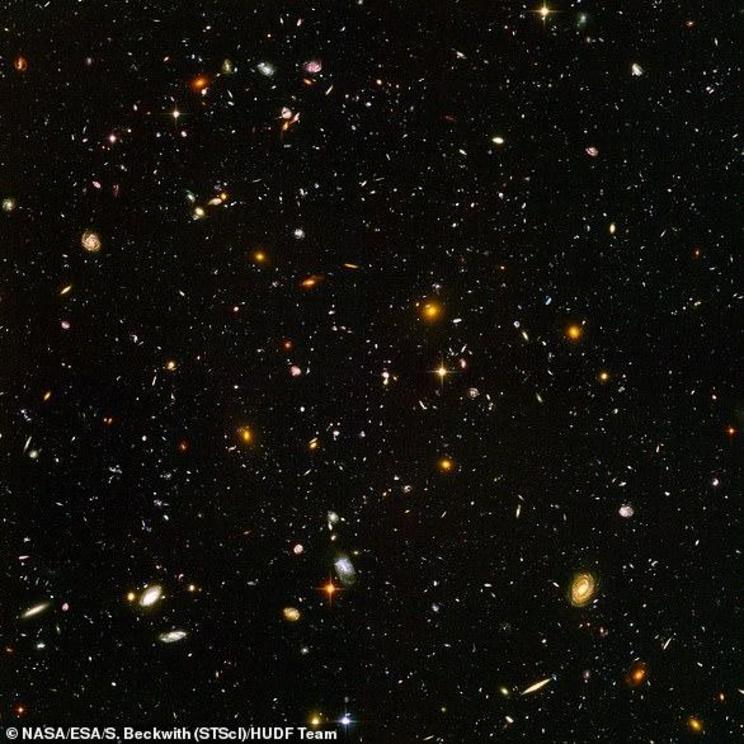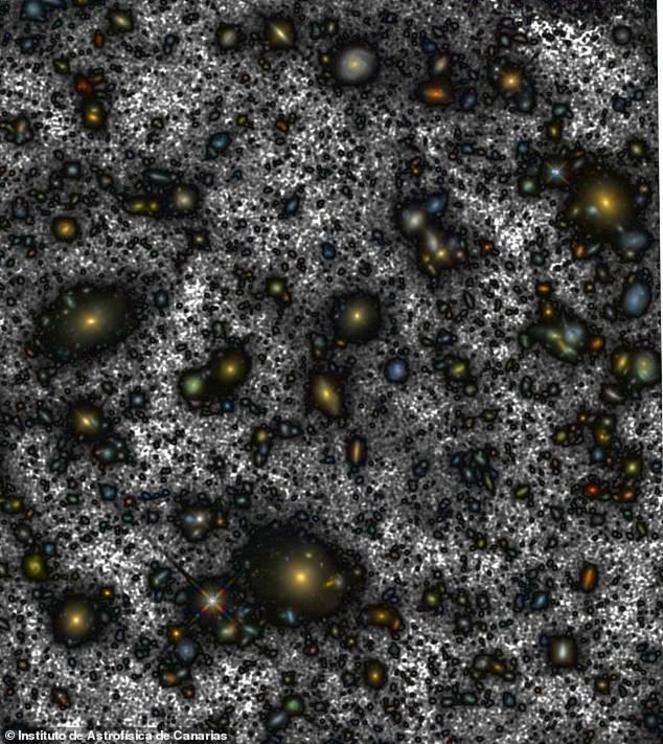Hubble 'lost light' image gives astronomers the deepest view into the Universe ever seen
- Researchers were able to process several Hubble images
- Reprocessing the image allow them to to recover a large quantity of light
- New image shows some galaxies were almost twice as big as previously thought
It is the deepest image of the Universe ever taken from space.
Astronomers used a new technique to reveal 'lost' light around the largest galaxies in Hubble Ultra-Deep Field images.
Researchers were able to process several Hubble images to reveal the new look at our Universe.
Astronomers used a new technique to reveal 'lost' light around the largest galaxies in the famous Hubble Ultra-Deep Field images.
Researchers at the Instituto de Astrofísica de Canarias spent three years producing the image,
By reprocessing the image, and combining several images, the group was able to recover a large quantity of light from the outer zones of the largest galaxies in the image.
'Recovering this light, emitted by the stars in these outer zones, was equivalent to recovering the light from a complete galaxy,' the team said.
For some galaxies this missing light shows that they have diameters almost twice as big as previously measured.
THE HUBBLE ULTRA DEEP FIELD IMAGE
The HUDF is the result of combining hundreds of images taken with the Wide Field Camera 3 (WFC3) of the HST during over 230 hours of observation which, in 2012, yielded the deepest image of the Universe taken until then.
This view of nearly 10,000 galaxies is called the Hubble Ultra Deep Field.
 This view of nearly 10,000 galaxies is called the Hubble Ultra Deep Field.
This view of nearly 10,000 galaxies is called the Hubble Ultra Deep Field.
The snapshot includes galaxies of various ages, sizes, shapes, and colours. The smallest, reddest galaxies, about 100, may be among the most distant known, existing when the universe was just 800 million years old.
The nearest galaxies - the larger, brighter, well-defined spirals and ellipticals - thrived about 1 billion years ago, when the cosmos was 13 billion years old.
The image required 800 exposures taken over the course of 400 Hubble orbits around Earth.
The total amount of exposure time was 11.3 days, taken between Sept. 24, 2003 and Jan. 16, 2004.
'What we have done is to go back to the archive of the original images, directly as observed by the HST, and improve the process of combination, aiming at the best image quality not only for the more distant smaller galaxies but also for the extended regions of the largest galaxies, said Alejandro S. Borlaff, who led the project.
The WFC3 with which the data were taken was installed by astronauts in May 2009, when the Hubble had already been in space for 19 years.
 The Hubble Space Telescope (HST) is seen in this March 9, 2002 NASA file photo with the Earth as a backdrop.
The Hubble Space Telescope (HST) is seen in this March 9, 2002 NASA file photo with the Earth as a backdrop.
This was a major challenge for the researchers because the complete instrument (telescope+ camera) could not be tested on the ground, which made calibration more difficult.
To overcome the problems they analysed several thousand images of different regions on the sky, with the aim of improving the calibration of the telescope on orbit.
WHAT IS THE HUBBLE SPACE TELESCOPE?
The Hubble telescope was launched on April 24, 1990, via the space shuttle Discovery from Kennedy Space Centre in Florida.
It is named after famed astronomer Edwin Hubble who was born in Missouri in 1889.
He is arguably most famous for discovering that the universe is expanding and the rate at which is does so - now coined the Hubble constant.
Hubble has made more than 1.3 million observations since its mission began in 1990 and helped publish more than 15,000 scientific papers.
 The Hubble telescope is named after Edwin Hubble who was responsible for coming up with the Hubble constant and is one of the greatest astronomers of all-time
The Hubble telescope is named after Edwin Hubble who was responsible for coming up with the Hubble constant and is one of the greatest astronomers of all-time
It orbits Earth at a speed of about 17,000 mph in low Earth orbit at about 340 miles in altitude.
Hubble has the pointing accuracy of .007 arc seconds, which is like being able to shine a laser beam focused on Franklin D. Roosevelt's head on a dime roughly 200 miles away.
Hubble's primary mirror is 2.4 meters (7 feet, 10.5 inches) across and in total is 13.3 meters (43.5 feet) long - the length of a large school bus.
Video can be accessed at source link below.

